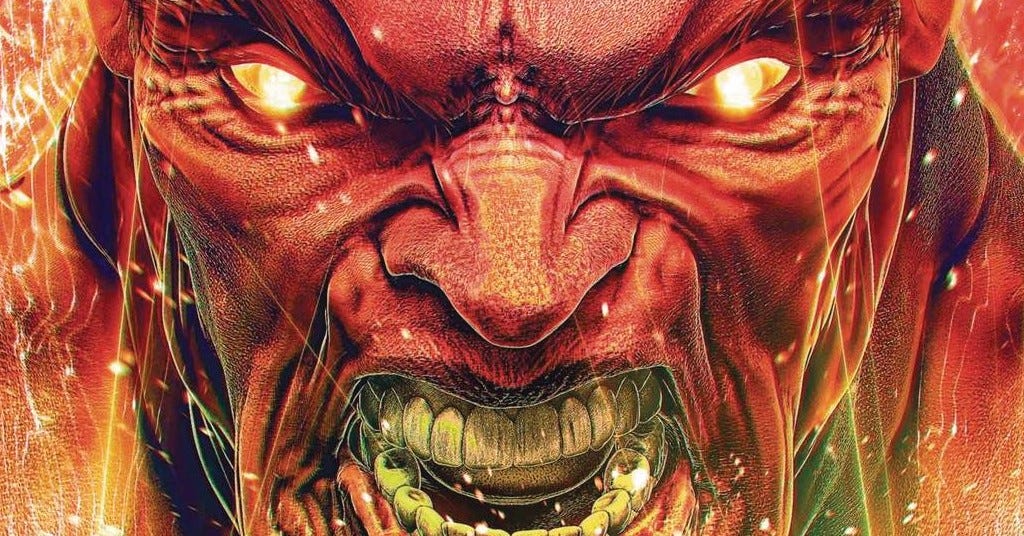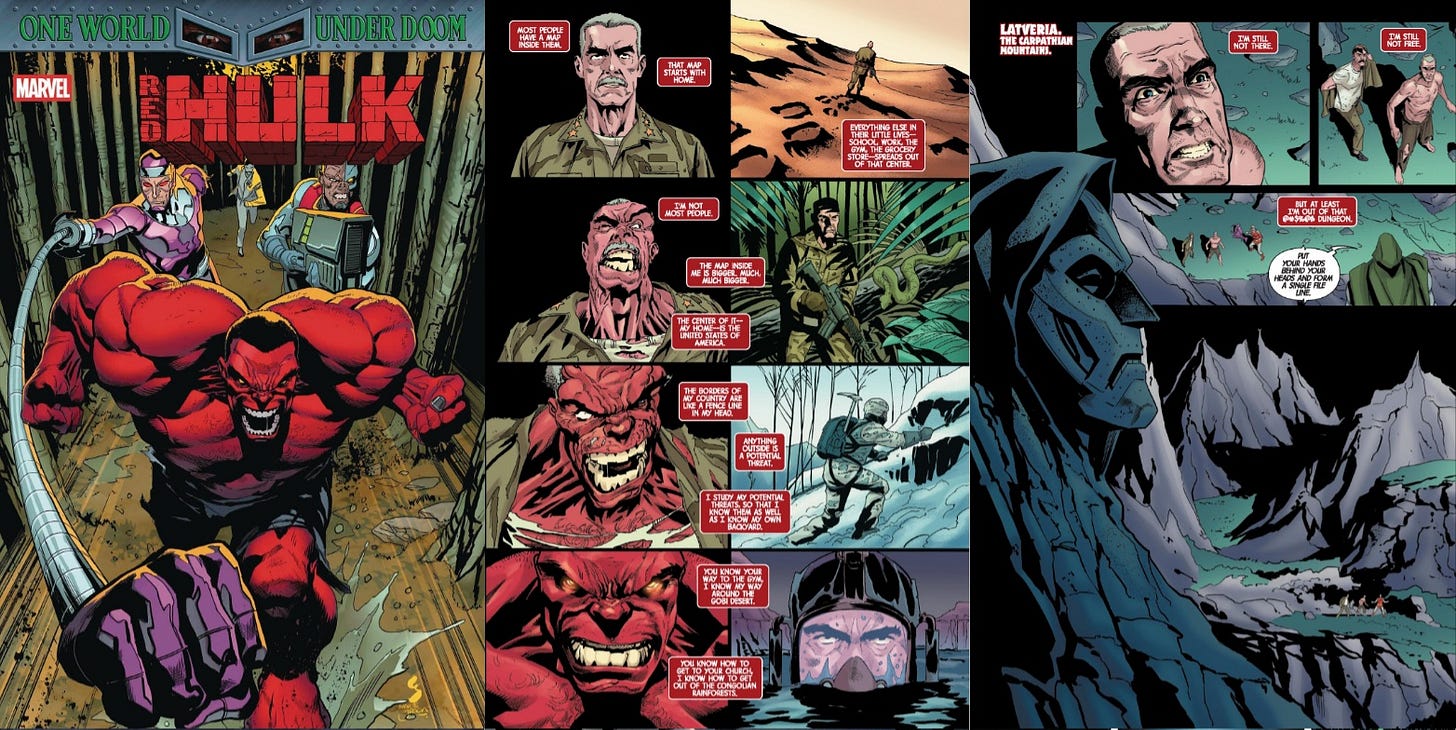“Uncharted Territory”
Writer: Benjamin Percy
Art: Geoff Shaw
Colors: Bryan Valenza
Letters: VC’s Cory Petit
Cover: Geoff Shaw & Marte Gracia
Variant Covers: Ben Harvey; John Giang
Publisher: Marvel Comics
Price: 3.99
Release Date: April 30, 2025
Now What?
Red Hulk is a crucible for General Ross. It grows hotter in each issue, stripping away Ross’s harder outer layers and getting to the core of the man. Percy isn’t just setting up a big fight between Doom and Red Hulk–he’s getting as far inside the man at the heart of the Hulk as he possibly can.
General Ross, Simon Ryker, Deathlok, and a de-powered Machine Man made it to the surface only to be immediately confronted by legions of Doombots. Ross knows the only way to win is to get irradiated and become Red Hulk, so he sets off for a distant nuclear power plant. Deathlok accompanies him, but Ryker sets off on his own–only to earn a quick and ignominious death. There may not be hope for any of them, though, when Doom himself returns to Latveria and joins the fight.
General Ross’s outlook in Red Hulk #3 is refreshing. In a way, Percy writes him as the equal and opposite of Reed Richards or Tony Stark. The general is just as capable of game planning for the future, but his way of dealing with problems is radically different from those other characters. Ross’s denunciation of relying too heavily on technology as well as his observation that “war is primal” gets to the heart of his character as well as his place in the larger One World Under Doom story. If Ross is going to confront Doom, he is not going to try and out-clever him.
Ross’s pool of allies continues shrinking in Red Hulk #3. A potential downside to this ongoing character attrition is that it robs Ross of one his strengths–that of commanding a group in battle. Given how much of the story is told via Ross’s internal monologue, is there a chance that the single mindedness demanded by the story makes him too one note in his thinking? Perhaps. But the benefit certainly outweighs that risk. The fewer characters Ross can rely on, the easier a time Percy will have pushing Ross down the path he’s designed: a desperate and more primal strength-on-strength fight with Doom.
This is also where Deathlok serves a vital role in Red Hulk #3. His dialogue, whether in conversation with Ross or just spouted off in fight sequences, provides something akin to comic relief. Much of it is sarcastic, and it provides necessary speedbumps to Ross’s anger and strategic self-absorption. Indeed, compared to many of Percy’s solo character books, Red Hulk #3 is relatively light on its protagonist’s internal monologue.
Detail And Organization
Shaw’s art and Valenza’s coloring don’t skimp on detail. Though not the most visually conspicuous part of Red Hulk #3, panel backgrounds showcase this attention to detail nicely. When focused tighter on characters, it would be easy for smaller panels to simply feature a one-color background that approximates night time. Instead, Shaw and Valenza almost always include something to establish the setting: outlines of trees, white flecks of snow, etc. Larger panels with wider looks feature white layers of snow giving dimension to otherwise dark trees, extra lines adding contour and unevenness to the snow covered ground, irregular shading giving dimension to background rock formations, and so forth.
Valenza’s strong work with regard to the setting also comes in handy in wider panels that feature multiple Doombots. Red Hulk #3 takes place in a tree dotted wilderness against a cold night sky. The Doombots’ green capes never get lost amidst similar colored surroundings that have the potential to make everything blend together.
The high level of art detail stands out more in character closeups, especially those that feature Deathlok. His face is heavily lined and craggy, some of the shapes around his mouth suggesting more the appearance of uncovered muscle than flesh. Hard angles and areas of all black shading give Deathlok’s face an almost emaciated look. While not every design offers the kind of canvas that Deathlok does when it comes to elaborate detail, this quality of work is clear on every character.
Owing to his tendency to tell stories largely via a character’s internal monologue, caption box placement is almost always a key visual element of a Percy written book. Red Hulk #3 is no different. Petit makes good positional choices throughout the issue, and especially so in the early pages as Ross reflects on the way he game-plans for future wars. On the 8-panel first page, Petit straddles the middle of the page with captions and it creates a stark visual duality between Ross as Red Hulk and Ross as general that the panel layout and art don’t quite achieve on their own. On the following pages, Petit positions some captions along Ross’s eyeline, as though the character is looking at his thoughts. Petit’s strong work helps tell the story of what is going on in Ross’s head.
Final Thoughts
Red Hulk #3 is a very good “now what?” issue: Ross escaped his dungeon, but that’s hardly the end of his problems. At the same time, Percy digs further into how Ross views warfare. In a larger event where all of Doom’s enemies are trying to outthink him, Red Hulk #3 sets up a potentially unique confrontation within the larger, momentarily predictable One World Under Doom framework.
What is good, everybody?
Thanks for reading the review of Marvel Comics’ Red Hulk #3.
If you enjoyed this review (or even hated it!)…
You can also find me on X and Bluesky where I’m very active.
Republished at Comic Watch.





